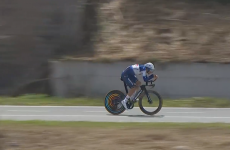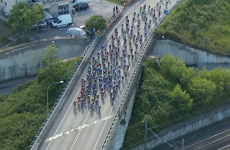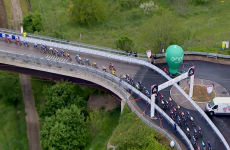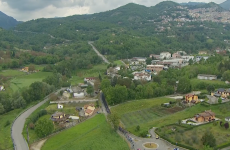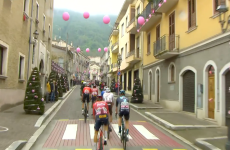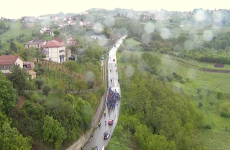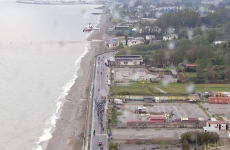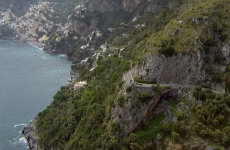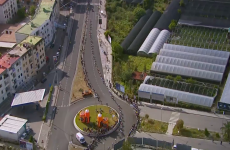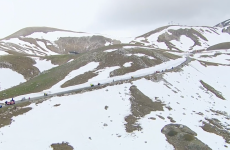Description
May 12, 2023
Giro d’Italia 2023 – Stage 7 – Capua – Gran Sasso d’Italia (Campo Imperatore) : 218 km
Falling in May, the Giro d’Italia welcomes in the start of the much-anticipated Grand Tour season.
Show more...
May 12, 2023
Giro d’Italia 2023 – Stage 7 – Capua – Gran Sasso d’Italia (Campo Imperatore) : 218 km
Falling in May, the Giro d’Italia welcomes in the start of the much-anticipated Grand Tour season. This is the time of the year where we see the climbers finally emerge, all vying for the same coveted prize – the coveted maglia rosa, or pink jersey. As is the case with all Grand Tours, the Giro route changes year on year as organisers send it around new areas of the country, seeking out ever more challenging parcours. Despite the route changing every year, the format remains very much the same. With a route that features no fewer than three individual time trials – adding up to a total distance of 73km – this year’s race looks set to favour those riders who are strong against the clock. There’s no shortage of legendary mountain passes though, in addition to three time trials the riders will also be faced with summit finishes atop Gran Sasso d’Italia, Monte Bondone and Tre Cime di Lavaredo. Across this year’s 3,481.9km-long route, riders will encounter no less than 54,331m of climbing – almost 2,000m than last year’s, an edition described by many as one of the most mountainous in years! Taking the sheer amount of climbing and abundance of ITT kilometres into account, this year’s Giro looks set to be one of, if not the hardest in recent memory.
Davide Bais (Eolo-Kometa) claimed a dream-like first pro victory on stage 7 of the Giro d’Italia, as the day’s breakaway made it all the way to the top of the Gran Sasso d’Italia while the overall contenders declined to trade any blows.
A bigger battle for the day’s breakaway might have been expected given the 218km parcours that led up to Campo Imperatore 2,130 metres above sea level, but Bais was part of a four-man move that went clear with a minimum of fuss and was rewarded with the biggest prize.
Karel Vacek (Corratec-Selle Italia) and Simone Petilli (Intermarché-Circus-Wanty) were the other members of the group who took an advantage of 11 minutes onto a final section of climbing that totalled nearly 50km. After ticking off the category-2 Calascio climb, they stayed together on the lower slopes of the final Gran Sasso climb, which measured 26.4km at 3.4% but really came down to the much steeper haul in the final 4.5km.
Petilli launched several accelerations and Vacek yo-yoed both off the back and front of the group, but it was Bais, keeping the lowest profile, who prevailed in the end. Biding his time, he waited for the opening accelerations in the final kilometre of the snow-lined climb before opening the taps himself, soaring convincingly clear in the final 250 metres.
Vacek crossed the line in second place, nine seconds in areas, with Petilli – whose acceleration had been the launchpad for Bais’ winning move – faded dramatically and had to settle for the final podium spot at 15 seconds.
Remco Evenepoel (Soudal-QuickStep) sprinted to lead the heavily-reduced peloton home a few minutes later, but it was still a large group and there were no gaps between the overall contenders. Andreas Leknessund (DSM) was present, correct, and presumably received at the lack of fireworks as he retained the pink jersey as overall leader of the Giro.
“I was lucky how the stage unfolded – it was only full gas in the last kilometre. I can be grateful for that and have some more days in pink,” Leknessund said. “I was expecting it to be harder. It was also quite boring, I’d say – I was looking forward to fighting – but of course I’m happy and grateful.”
It was a somewhat strange situation as the first major climbing stage of the 2023 Giro, so highly-anticipated, fell flat from a general classification perspective. DSM controlled the pace all day but no one seemed interested in chasing the breakaway in the Sulmona valley, and no one seemed interested in any sort of aggression on the final climbs – largely because of the prevailing headwind. AG2R Citroën – who have Aurélian Paret-Peintre in third overall – showed a brief flash of interest, while second-placed Evenepoel’s QuickStep men dictated on the plateau between the climbing sections of the Gran Sasso climb, but the expected selections on the steep final kilometres never materialised.
Thomas Champion (Cofidis) launched a speculative and short-lived attack, before Movistar lifted the pace for a kilometre or so, but it was down to the final 300 metres for the pink jersey contenders to really show their faces. Evenepoel launched a strong sprint, but Roglič was perfectly alive to it, and there were no gaps back to the other members of the group.
HOW IT UNFOLDED
The stage started out in relatively quiet fashion, the expected battle for the breakaway not materialising. As it was, four riders clipped away early on with a minimum of fuss: Davide Bais (Eolo-Kometa), Henok Mulubrhan (Green Project-Bardiani CSF-Faizanè), Simone Petilli (Intermarché-Circus-Wanty), and Karel Vacek (Corratec-Selle Italia).
Leknessund’s Team DSM quickly came to the front of the peloton but they allowed the escapees to gain the biggest margin so far at this Giro. As the gap passed the eight-minute mark after 60km, Petilli, who started the day 7:49 down, was the virtual leader of the Giro. The gap then reached 10 minutes as the rain returned and many riders stopped to grab layers, but then it started to come down slightly.
The first intermediate sprint came after 91km at Castel di Sangro, where Bais claimed maximum points. The first categorised climb came immediately after, with Bais claiming maximum mountains points atop the short category 2 haul up to Roccaraso. Mulubrhan was dropped from the breakaway on the climb and spent a long time drifting back to the peloton, with DSM having allowed the gap to ease back out above the 11-minute mark.
The riders then descending into the Sulmona valley for a long stretch ahead of the final climbs. It was a quiet phase of the race as the there remaining breakaway riders plugged away and DSM controlled the peloton without making any major inroads. The gap was down to 10 minutes by the second intermediate sprint, where Bais was first over the line in an uncontested affair, but then it started to grow again on the final 15km approach to the mountain.
On paper, it looked more like one long final climb but it was divided in two, with the category-2 ascent of Calascio – 13.5km at 6% – beginning with 45km to go. Even the final climb of Gran Sasso d’Italia – officially measuring 26.4km at 3.4% – was divided up, with a steady 10km followed by a 10km rolling plateau and then another 6km climb, ramping up to a stinging average gradient of 8.2% over the final 4.5km.
DSM continued to work on Calascio, where there was another chain drop for Geraint Thomas, who got back in easily enough with the help of three Ineos Grenadiers teammates. As for Soudal-QuickStep, they lost Davide Ballerini and Josef Cerny but kept five others around Evenepoel.
At the top of Calascio, Bais once again took maximum mountains points ahead of Petilli and Vacek, before – nine minutes later – Thibaut Pinot (Groupama-FDJ) eased clear of the peloton to help himself to the four remaining points and extend his lead in the mountains classification.
As the road continued to rise, DSM found company at the head of the bunch, with Bahrain Victorious, AG2R Citroën, Soudal-QuickStep, and UAE Team Emirates all moving forward. But the pace was still not high. By the top of the sustained 10km section of non-categorised climbing, with 10km of plateau to follow ahead of the final climb, the breakaway trio still had seven minutes in hand and stage victory effectively in their hands.
QuickStep then took charge of the peloton on that flatter section but declined to really up the pace, and the leaders entered the final 6km – where the road started to ramp properly climb once again – with 6:30 in hand. That’s where Petilli, wasting no time, decided to launch the first attack for the stage win, succeeding in placing Vacek in brief difficulty even if the trio remained together until the steeper stuff with 4.5km to go.
Vacek looked to dictate the tempo but he was distanced again by an even stronger Petilli acceleration with 3.5km to go, although he managed dangle a few metres off the back before clawing his way back with 3km to go. He then looked to launch a surprise by accelerating himself.
The bunch hit the steeper slopes just under six minutes down but there seemed to be no appetite for aggression, with Evenepoel chatting and smiling, and Cofidis’ Thomas Champion launching a somewhat random attack. He was soon caught as Movistar took it up and, finally, lifted the pace.
Up front, the same situation repeated itself just inside the 2km-to-go banner, as Vacek was distanced briefly, then came back, and even then shot out front with 1400 metres to go, although Petilli quickly brought him to heel. The trio entered the final kilometre and things became cagey. Vacek was happy to lead the way and he upped the temp out of the saddle with 600 metres to go, going again with 400 metres to go but not shaking his rivals.
Petilli then launched on the left with 300 metres to go, Bais quickly responding before moving clear as Petilli locked up and faded fast. Bais soared clear to open a big gap and lift his arms on the line, with Vacek passing Petilli to take second place.
A few minutes later, Geraint Thomas (Ineos Grenadiers) came to the fore as the bunch – now heavily reduced despite the slow pace – came into the final kilometre. The only big acceleration came from Eddie Dunbar (Jayco-AlUla), which was followed by Thomas before Evenepoel opened his sprint. Roglič was at ease in marking it, and there were no other gaps behind, meaning it was a non-event in the overall context of the race, with Sunday’s time trial marking the next key battleground.
Results :










